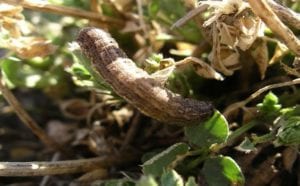By Lexie Maloy
Product Marketing Intern
Alfalfa crops face many insects throughout their growing season. Some of these insects are beneficial and control a variety of pest species throughout the season, while others have the ability to decrease forage tonnage and quality. The alfalfa weevil and the army cutworm have the potential to impact yield and become an economically important pest if not treated in a timely manner. Army cutworms were a big problem in 2020 and alfalfa weevils are the number one potential pest every year throughout the alfalfa-growing region. In order to know how to manage these two pests, it is important to have basic background knowledge about each of them.
Army cutworms cause the most damage in the spring when the weather warms above 60-70° Fahrenheit for three to five days in a row. The larvae hatch in the fall and feed until cold weather sets in, then they typically finish feeding by late April. These pests consume more plant matter the larger they get. Army cutworms are usually a bigger problem if dry conditions have slowed plant growth.
Alfalfa weevils typically cause the most damage before the first cutting. Adults begin laying eggs as soon as the temperature exceeds 48° F. Development of these pests is completely dependent on the weather; warm temperatures early in the season allow these pests to develop earlier than normal and continue to hatch throughout the spring.
Controlling army cutworms and alfalfa weevils is all about the timing. If you detect an infestation of either pest in your field, check to see they have reached the threshold. The threshold for army cutworms is two to four larvae per square foot present in seedling fields; or when four or more per square foot are found in established fields.
The threshold for alfalfa weevil is an average of three or more weevils per stem throughout an area. If the field has reached one of these thresholds or is close to reaching the threshold, you should talk with your AgVenture Yield Specialist about potential control options. They may look into seeing if there is enough of a threat to warrant a treatment pass. Even if the field has not reached the threshold, a combination of pests may cause enough of a threat to economically justify a treatment option.

